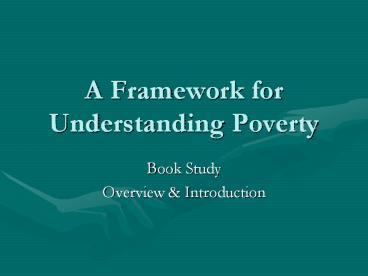A Framework for Understanding Poverty - PowerPoint PPT Presentation
1 / 33
Title:
A Framework for Understanding Poverty
Description:
A Framework for Understanding Poverty Book Study Overview & Introduction Key Points to Remember Poverty is relative. Poverty occurs in all races and in all countries. – PowerPoint PPT presentation
Number of Views:487
Avg rating:3.0/5.0
Title: A Framework for Understanding Poverty
1
A Framework for Understanding Poverty
- Book Study
- Overview Introduction
2
Key Points to Remember
- Poverty is relative.
- Poverty occurs in all races and in all countries.
- Economic class is a continuous line, not a
clear-cut distinction. - Generational poverty and situational poverty are
different. - This work is based on patterns. All patterns
have exceptions.
3
Key Points (continued)
- An individual brings with him/her the hidden
rules of the class in which he/she was raised. - Schools and businesses operate from middle-class
norms and use the hidden rules of the middle
class. - For our students to be successful, we must
understand their hidden rules and teach them the
rules that will make them successful at school
and at work.
4
Key Points (continued)
- We can neither excuse students nor scold them for
not knowing as educators we must teach them and
provide support, insistence, and expectations. - To move from poverty to middle class or middle
class to wealth, an individual must give up
relationships for achievement (at least for some
period of time). - Two things that help one move out of poverty are
education and relationships. - Four reasons one leaves poverty are Its too
painful to stay, a vision or goal, a key
relationship, or a special talent or skill.
5
Some Statistics about Poverty
- See page 4-6 in your text.
6
Definition of Poverty
- The extent to which an individual does without
resources - Poverty is more about lack of resources than it
is about money
7
Eight types of resources
- Financial
- Emotional
- Mental
- Spiritual
- Physical
- Support Systems
- Relationships/Role Models
- Knowledge of Hidden Rules
8
Financial
- Having the money to purchase goods and services
9
Emotional
- Being able to choose and control emotional
responses, particularly to negative situations,
without engaging in self-destructive behavior.
This is an internal resource and shows itself
through stamina, perseverance, and choices.
10
Mental
- Having the mental abilities and acquired skills
(reading, writing, computing) to deal with daily
life.
11
Spiritual
- Believing in divine purpose and guidance.
12
Physical
- Having physical health and mobility.
13
Support Systems
- Having friends, family, and backup resources
available to access in times of need. These are
external resources.
14
Relationships/Role Models
- Having frequent access to adult(s) who are
appropriate, who are nurturing to the child, and
who do not engage in self-destructive behavior.
15
Knowledge of Hidden Rules
- Knowing the unspoken cues and habits of a group.
16
Small group activity
- Scenarios
17
Table discussion
- Which resources can an educator influence greatly?
18
The Role of Language and Story
- Registers of language
- Discourse patterns
- Story structure
19
Registers of Language
- Every language in the world has five registers
- Frozen
- Formal
- Consultative
- Casual
- Intimate
20
Frozen register
- Language that is always the same.
- Examples The Lords Prayer, wedding vows, etc.
21
Formal register
- The standard sentence syntax and word choice of
work and school. - Has complete sentences and specific word choice.
- Majority of minority students and poor students
do not have access to formal register at home.
22
Consultative register
- Formal register when used in conversation.
- Discourse pattern not quite as direct as formal
register.
23
Casual register
- Language between friends and characterized by a
400- to 800-word vocabulary. - Word choice general and not specific.
- Conversation dependent upon non-verbal assists.
- Sentence syntax often incomplete.
24
Intimate register
- Language between lovers or twins.
- Language of sexual harassment.
25
Research about registers
- Every language in the world has five registers.
- One can go down one register in the same
conversation and that is socially acceptable. - To drop two registers or more in the same
conversation is to be socially offensive. - (Joos, 1967 )
26
Discourse Patterns in Formal and Casual Register
- Formal register
- Pattern is to get straight to the point
- Casual
- Pattern is to go around and around and finally
get to the point
27
Primary Discourse
- The language an individual first acquired.
28
Secondary discourse
- The language of the larger society that the
individual must be able to use to function in the
larger society.
29
Story structure
- Formal-register story structure
- Chronological, narrative
- Most important part of the story is the plot
- Casual-register story structure
- Vignettes with audience participation
- Most important part of the story is the
characterization
30
Demonstration activity
- Cinderella
31
Table discussion
- How does type of story structure affect learning?
- (see page 33)
- What can schools do to address casual register,
discourse patterns, and story structure? - (see page 34)
32
Our Book Study
- Copy of A Framework for Understanding Poverty
- Copy of study guide
- Read assignments ahead of time
- Pre-approved by the district for credit
- Study groups October/November
- Led by one teacher (NBCT)
- Faculty meetings
33
Where do we go from here?

